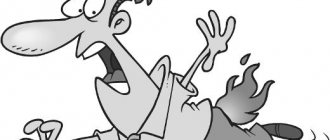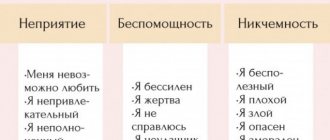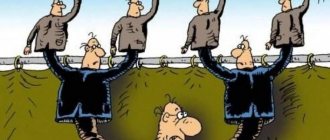Like any other action, a lie leaves an imprint on a person’s facial expression, behavior, and posture. Knowing these changes, you can determine the degree of sincerity of the interlocutor. Although in fairness, it should be noted that, unlike other psychological states, lies are more difficult to detect. There is no one universal sign of lying; judging by just one “symptom”, one can come to the erroneous conclusion that almost all people lie. However, there are certain types of behavior that may indicate that a person is experiencing stress, anxiety or psychological discomfort during a conversation.
You can only understand the true cause of restless behavior if you know the person well. It is necessary to know how he behaves in an ordinary, familiar environment, then all the metamorphoses that his behavior undergoes will be obvious. If you don’t know a person well, then it is better to start a conversation with abstract topics, general “harmless” questions, thanks to which you can get a general idea of the manner of communication, facial expressions and characteristic gestures for him, and only after that proceed to questions whose answers interest you . You should not pretend to be an investigator; this may cause anxiety in your interlocutor, which will distort the picture of natural behavior.
There are many signs that show up when a person is lying; 2 or more signs give reason to assume that the interlocutor is insincere. Assumption may give way to certainty if 3 or more signs are present. Characteristic signs of insincerity usually include:
Verbal signs of lying
- The eyes are the mirror of the soul, perhaps that is why liars cannot bear to look directly into the eyes and pretend to look at their surroundings and random objects. In fairness, it is worth noting that sometimes people who tell the truth can lower their eyes and avoid the gaze of their interlocutor, as they describe facts that do not characterize them from the best side. Moreover, many liars know about the existence of this sign and, wanting to prove their “sincerity,” they persistently look into the eyes of their interlocutor. Often a lie is revealed by rubbing the eyes or rapid blinking.
- Changing the tempo and pitch of the voice (if the person does not have speech impediments). Repeating the interlocutor’s question, answering a question with a question, too many hesitations and pauses indicate that the person is making it up on the fly, and therefore slows down the pace of speech in order to gain time to compose a story.
- Bustle. Lying often leads to a person becoming fussy. The intensity of the manifestation of this symptom depends on the habituality of lying for a person. Anxiety manifests itself in the fact that a person cannot find a comfortable position, constantly moves, changes his position, taps his fingers on the table, jerks his leg, bites his lips.
- Reservations, contradictions. A liar can be caught by being attentive to the details of his story; people often make unconscious slips and get confused about the facts. However, if a person constantly remembers something and adds new details to the story, then most likely he is telling the truth.
- Changing the topic of conversation. A liar may try to take the conversation to a different plane, but such a turn is also possible in the case when a person is simply bored with the topic of the conversation or is unpleasant for him for some reason. Therefore, this sign has weight only in combination with others. An excess of details that are not related to the topic of the conversation indicates that the person is trying to distract the interlocutor from important points. When changing the topic of conversation, a liar will happily jump at the opportunity to escape from an unpleasant conversation, while an honest person would prefer to find out everything to the end.
Non-communicative gestures
Gesture adapters – stress gestures
A more informative sign of a state of stress are non-communicative gestures - the so-called adapter gestures. They are also called self-soothing gestures. A person resorts to them unconsciously in order to regain peace of mind in a stressful situation. The appearance of adapter gestures is a sure sign that a person is trying to take control of himself and the situation. In this case, the verifier needs to answer the question: “Why did the person being interviewed begin to control himself?” It must be borne in mind that these gestures are unconscious - they are poorly conscious.
Self-adapter gestures, as a rule, are associated with touching oneself, one’s body. By observing the level of manifestation of self-adapter gestures, one can judge the level of stress of a person. The higher the self-adaptive gestures, the higher the stress level. When a person covers his face with his hands, in different contexts the verifier can confidently talk about shame, disgrace or grief.
Types of self-adapter gestures
- Touching the head;
- Touching the body;
- Legs.
Manipulative Gestures
Adaptive gestures also include manipulative gestures, which perform the same function as self-adapter gestures, but they are based on manipulation of objects. A person who lies undergoes a transition from the right hemisphere to the left, and it is during this period that manipulative gestures appear. This is due to the fact that the transition from the right hemisphere to the left always causes a pause in a person’s actions. Therefore, the function of manipulative gestures is not only adaptation, but also substitution. Moreover, each person has his own especially favorite manipulations that are unique to him.
The duration of manipulations can vary from a few moments to many minutes.
Manipulative gestures are used by a liar in two cases
- Masking of the point of indicative freezing (uncontrolled pause before answering);
- Coming up with the correct answer to a question.
Understanding the reason for the occurrence of manipulative gestures, the verifier, when asking a test question and if there is a manipulative gesture in a truthful answer, must double-check it by asking a question in a different wording after some time.
In a lie detection situation, there is no need to determine the exact meaning of each adapter gesture if the verifier pays primary attention to the structure of speech utterances. Since adapter gestures signal the level of stress, during the interview the verifier can understand how close he is to the required information
Self-cleaning gestures
A person tries to control himself in the presence of an observer or a group of observers, because it is believed that in the presence of other people it is indecent to perform gestures of self-purification. A person resorts to these gestures when he believes that no one sees him. Or a person begins to perform these actions unconsciously if he has the feeling that no one sees him.
In life, a person purifies himself, as a rule, in private, when no one sees him, he is in a complete state of immersion, focused on himself, and most importantly, he is safe.
For lie detection, this reason for the emergence of self-cleaning gestures can be quite informative and significant. In the situation of a survey conversation, and especially this can be informative in the case of a group conversation, the presence of self-purification gestures in a person’s non-verbal behavior indicates the absence of the emotion of fear, lack of interest in the event under investigation and is an additional marker of a person’s non-involvement.
Gestures of self-purification indicate a lie when the person being interviewed reports a strong emotional experience, but at the same time demonstrates actions to self-purify himself.
Another informative sign that can be attributed to information about the presence of deception is the absence of any gestures throughout the entire interview conversation. Some liars, wanting not to give themselves away, try to control all body movements and facial expressions. It looks as if the person has become stiff. At the same time, speech becomes brief, logical and not emotionally charged. The verifier immediately identifies this behavior as information about the presence of deception. Often liars do not understand that trying to suppress everything in themselves is evidence of hiding information.
Thus, due to the ambiguity of the origin of gestures, they must be interpreted and interpreted with extreme caution. A liar is given away by emblematic slips, an increase in the number of adapter gestures, dissonance of illustrators, an increase in the number of illustrator gestures in people with a fast mobile nervous system
Nonverbal signs of lying
- Self-defense. A person who has nothing to hide does not need to worry about self-defense, show aggression and other negative emotions, trying to shield himself. The “closed” posture typical of this state can also speak of self-defense: a person strives to turn away from the interlocutor as much as possible, fence himself off with objects, cross his arms in front of him or hide them in his pockets, cross his legs, and hunch over.
- Typical signs of lying: frequent touching of the nose, eyes, lips, neck, hair, coughing - indicate a person’s anxiety, but at the same time, these gestures can indicate the presence of allergic manifestations. Touching the neck and hair is often used by women when flirting. Sometimes “suspicious” behavior results from excessive anxiety about the need to voice the “bitter” truth.
- Conflicting body language. When a person says one thing, but his facial expressions and posture express something completely different, for example, a person agrees to a proposal to go to the cinema, but the expression on his face expresses a complete lack of enthusiasm for this idea, then it is quite reasonable to assume that he is lying. Feigned good nature, benevolence or irony often become a cover for a liar who needs to convince his interlocutor that he has no reason to worry and be nervous.
- Body Even if a person maintains external calm, his body expresses signs of psychological discomfort, regardless of his desire, he becomes covered in perspiration, breathing and heartbeat become more frequent, dry mouth appears, and the pupils dilate.
- Skepticism: people who are accustomed to insincerity, in most cases, are distrustful of other people, since they believe that everyone is subject to this vice, while honest people easily trust others.
Attentive attention to your interlocutor and his body signals during communication can tell a lot about his attitude towards you and the degree of sincerity.
Relationships with them are impossible.
If you believe that you can be friends with such people or, God forbid, maintain a love relationship, then you are deeply mistaken. After all, the very first condition for any relationship is trust. How can you trust someone who constantly lies?
If you can't trust your friend or loved one, then why be in a relationship? To be led by the nose and constantly deceived?
A pathological liar will betray you at every turn. At the same time, he will also try to frame everything as if you have gone crazy and are to blame for everything yourself. In the end, they will simply destroy you as a person. You will no longer distinguish between what is true and what is a lie, what was told to you and what was “heard.”
There is only one way out - run as far away from them as possible!
Signs of a liar
How to understand that a man is deceiving a woman? It is enough to ask some questions and carefully monitor the person’s reactions. It is by gestures and facial expressions that a liar can be identified.
There are a lot of lies in life. But the most unpleasant lie is when it comes from close people. How to recognize it?
- Avoiding answering a question
This may indicate that he simply does not want to say anything so as not to lie. Or he is afraid that he will be “pinned to the wall.”
- The man shakes his head to the sides
This indicates that he in every possible way denies his own words.
- Frequently touching your face with your hands
- The pupils dilate, while the gaze avoids contact with the woman’s eyes
The gaze is directed slightly down and to the side.
- Man's constrained behavior
He tries to suppress his emotions, so he becomes clamped and constrained.
- Difficult answers to clarification questions
Often, it is clarifying questions that help determine whether a person is lying or not. He may say one thing at first, and after a while - something completely different. In your questions, specify certain details that will help check the man.
- Frequent eye blinking
In one minute, a person in a calm state blinks about six times. The liar begins to do this much more often. In addition, there is a short pause before answering the question.
- Confusing questions
Typically, such questions include those that require a specific answer: affirmative or negative.
- Raise your eyes a little to the right and up
It is very easy to determine what a man is doing when answering a question - lying or remembering. Every person's brain is divided into left and right hemispheres. The left is responsible for memory, the right for imagination. If a man raised his eyes to the right, it means he is coming up with an answer, if to the left, he is remembering.
- Excessive enthusiasm when describing certain events
Enthusiasm can manifest itself in changes, for example, in the tone of the voice, etc. At the same time, attention is drawn to certain objects. A liar does this to hide any changes in his behavior from the woman.
Do not forget that there are skilled liars in this world who are almost impossible to bring to clean water. The good news is that there are significantly fewer such craftsmen than ordinary people.
How to find out that a person is lying: ways
For you, as for me, of course, it is important to stop the manipulator of our trust in time! So, gaining experience on how to spot a lie
According to human gestures
A person's gestures and posture can tell you a lot. Let's start with the “closed pose” - a person crosses his arms and legs, he closes himself. This is due either to discomfort or to the desire to close themselves off from you.
If your interlocutor constantly fidgets, something is clearly stressing him out! And most often this is precisely a possible exposure, especially if the palms are closed.
Each person speaks at a certain pace. So here’s another secret of psychology: if his speech and gestures do not match in tempo, then in front of you is the spitting image of a liar!
A few more signs of lies:
- a person often touches his nose;
- hands constantly in the throat, mouth;
- rubbing hands;
- fingering various objects;
- the interlocutor tries to light a cigarette when you start to dig in, or bites his lips;
- the position in space also changes - the person seems to be trying to increase the distance, so he takes a step back, but this works when you are perceived as a real threat of exposure;
- Palms are considered the second indicators of truth after the eyes, so if they are carefully hidden in pockets, behind the back, etc., then this is a clear indicator of a lie.
Recognizing lies by human gestures
By facial expressions
Lying is not characteristic of man; he has to lie in circumstances that threaten him. Therefore, unreliable information is accompanied by tension. When your interlocutor deceives you, watch his facial expressions.
The main signs of lying by facial expressions:
- complexion changes: it either darkens or turns pale;
- slight twitching of the eyelids is observed;
- watch the blinking - it speeds up.
Such phenomena are often accompanied by rubbing of different parts of the body. This is a reaction of the brain - it wants to block the untruth. But blinking reveals an inner desire to close your eyes to everything.
By the eyes
Psychologists no longer claim that liars hide their eyes in conversation. There were manipulators and deceivers who were skilled in their craft. But still, one can suspect a lie from the eyes.
Let's start with the fact that lying, especially for a beginner, is stressful. How does our body react to stress? In a conversation, you may see dilated pupils and an unnatural shine in the eyes.
Statistics, a stubborn thing, say that women often look up when cheating, and men, on the contrary, look down.
Also pay attention to frequent blinking, aversion of the eyes, which is replaced by attentive observation of you. This is how the interlocutor monitors whether you listen to him carefully and whether you trust him.
If you want to learn how to “read” people by their eyes, watch the video below:
By correspondence
It is much easier to identify a deceiver by facial expressions, eyes and gestures than by correspondence. It is difficult to change something that is already on paper or a storage medium. That's why people lie less often via correspondence to their friends. But how do you know if someone is lying to you via correspondence on the Internet? We determine when a person is lying, grab these life hacks:
- long typing (if you can see it) indicates that the person is choosing his words, and this is the first indicator of insincerity;
- with a burning question, you do not receive an answer at all or receive an answer to another topic in the text - a sign of concealment of information, that is, a lie;
- you ask a question, and you are accused of playing on feelings, conscience and all mortal sins - the person is lying or being a hypocrite;
- in sensitive topics, you ask a direct question, and your opponent “turns on the fool”, pretends that he has forgotten or devalues your feelings;
- constant excuses or complaints - insincerity of the interlocutor;
- You constantly receive phrases like “maybe”, “I’ll try”, “anything can happen” - manipulation or deception.
Keep in mind that lies can happen for various reasons, and people can be talkative or silent, so it’s better to talk “to be honest” so as not to get lost in guesswork and not create problems with the person.
But it’s difficult to distinguish truth from lies in a relationship, especially if the guy or girl is interested in you. To do this, use all methods: look at gestures, in eyes, ask direct questions and observe the reaction. But there is also no need to overdo it - there is a danger of losing real relationships.
How to distinguish truth from lies
Each person perceives truth and lies differently. We are interested in a person's reaction to untruth. How he perceives it and how he reacts. What pushes people to lie?
As everyone knows, truth and lies are moral categories that influence a person in one way or another. Each of us lies in life, some more, some less. If you ask a person why he is lying, we will get a fairly simple answer. You will hear that there are many reasons for lying. I lie at work in order to make a good impression on business partners or employees. I lie in my family so that they worry less and don’t get nervous over trifles. You can also hear the answer that lying or untruth is a reaction to an attack and a way of protecting against difficulties and problematic situations. Often lying is a way to protect loved ones and family. But still, how does a person perceive the fact that he is being told a lie?
Reaction to lies
Each person has their own reaction - some are indignant, some will simply take note, and some will simply closely monitor the person who is lying. He will note certain actions, which will then correspond to the fact that the person is lying.
There are quite a large number of theories and algorithms for tracking liars in the world. And each of the methods is unique in its own way, but they have a lot in common. You can select from the entire amount of information what will help you identify liars.
- Firstly, if you don’t believe a person and want to catch him in a lie, just start watching his eyes and face. While lying, he will touch the corner of his nose or mouth with his hands, and may cover his mouth with his hand.
- Try to follow your eye movements. Most often, when people lie, they look to the right and blink more often. They do not make eye contact or may stare into your eyes.
- In addition to the eyes, the body says that a person is lying. Most often, your opponent tries to stand sideways or at a distance.
Thus, it can be argued that a lie is a person’s defensive reaction to various factors, and everyone reacts to it in their own way. But still, a lie will not always help you achieve the desired result, no matter how you look at it, the truth is the most powerful argument in a dispute, in a person’s life.
Psychologist Konstantin Lysenko
Gestures, facial expressions, eye movements can tell more about your interlocutor than he himself sometimes wants. Knowing sign language is the key to successful negotiations and sales. A small Quiz test will help you understand how well you understand non-verbal communication.
Lies in the eyes
There are often tips to recognize lies by eye movements . Like, if the eyes go up and to the left, then the person constructs an image, and if up and to the right, he remembers what actually happened. But this method has so many caveats (for example, for left-handed people, everything happens exactly the opposite) that I would not recommend relying only on this criterion. It's very easy to get into trouble. And in general, take into account only the totality of signs. Even experienced experts on emotions and their expression, such as Kal Lai, make mistakes.










